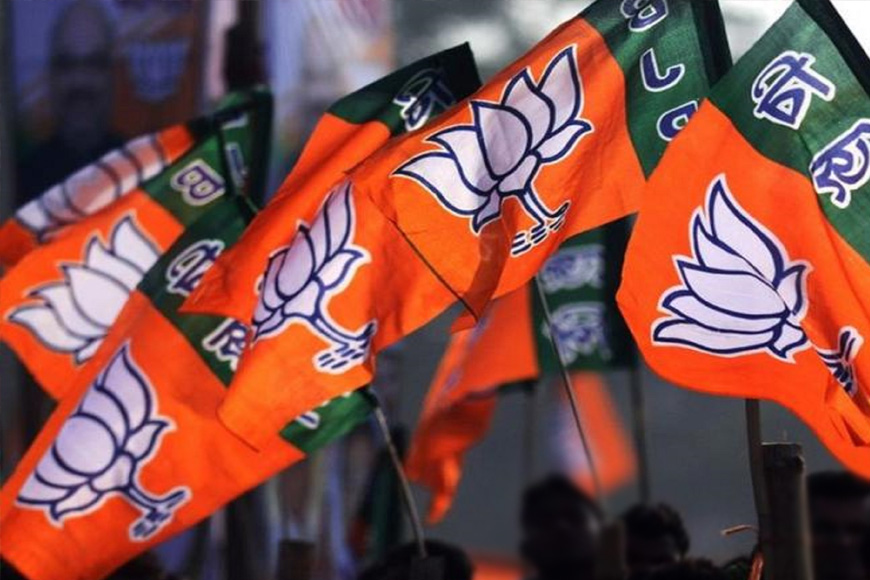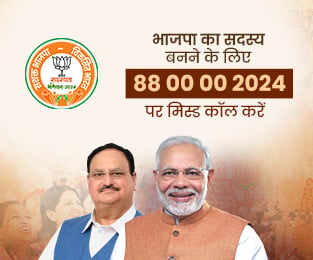
Download Hindi PDF |
Download English PDF |
Bharatiya Janata Party
National Executive Meeting
12-13 June 2016, Allahabad
Resolution-1
Bharat world’s fastest growing economy
India has emerged as a bright spot in a world in recession, in which most of the nations are facing a slowdown and decline in growth. After inheriting a very bad economy, amidst global slowdown and successive two years of drought, India under the exceptional leadership of Prime Minister Sh. Narendra Modi, emerged as the fastest growing economy. Economic experts, think tanks, multilateral institutions and reputed media have acknowledged India’s growth story. They have hailed various schemes and initiatives of the government.
This is not just by chance, but due to extensive and persistent efforts by the government of Sh. Narendra Modi and its prudent policies. After inheriting a mismanage economy from the previous government of UPA, the task of the new government was two-fold. First it had to undo the bad effects of the previous government including policy paralysis, mis-governance and corruption and secondly to make the economy embark on the path of development.
India’s GDP had grown to 7.2% in the year 2014-15 and 7.6% in 2015-16. It is significant to note that last quarter witnessed GDP growth rate of 7.9%. Despite severe resource constraints, we could achieve fiscal deficit of 4.1% and 3.9% in the year 2014-15 and 2015-16 respectively. Also, better supply management and control on fiscal deficit has resulted in control of inflation. India received an unprecedented amount of foreign direct investment (FDI) in the calendar year 2015 and this has helped us in increasing surplus in balance of payment on capital account. This coupled with surplus in balance of payment on current account recorded in the third quarter of 2015-16.
Inheritance of mismanaged economy
During UPA regime international community had started writing off India: terming it as a laggard economy. Last two years of UPA regime were the worst from the point of view of the industry, infrastructure, price stability (inflation), health of banking sector, external sector imbalances and fiscal management.
In the year 2011-12, the GDP growth had slowed down to 6.5%. Industrial growth in that year had decelerated to merely 2.9%, which further declined.
Fiscal deficit approached 6% of GDP and rupee depreciated fast. During UPA regime, about 14 lakh crore rupees worth of funds got locked up due to wrong policies. RBI’s Financial Stability Report, December 2015 showed that the PSU banks were in a very bad shape. Crony capitalists succeeded in influencing the decision making process. Whether it was telecom or coal or any other field, there was complete policy paralysis.
India – a bright spot in a world in recession
According to OECD estimates the world economy is expected to grow less than 3% this year, the same as in 2015. Almost all countries including China, Brazil, are in the grip of recession. Not only the developed economies, but also developing ones are also facing a decelerated growth. There is a decline in the role played by global trade in pushing economic growth and propelling growth of developing nations. Towards the end of 2015 the global trade growth had declined to as low as 0.6%. In real terms the global trade declined from $19 trillion in 2014 to $16.5 trillion in 2015. The economic performance of China has significantly declined during the last two years. For the first time in the last 25 years, GDP growth of China has slowed down to 6.9% in 2015. The growth rate during 2016 declined further, with the rate going down to 6.7% during the first quarter. In contrast the Indian economy has been posting higher growth and has emerged as the fastest growing economy of the world.
Policies for India’s growth
Increased capital spending in infrastructure development, increased credit for agriculture and small industries has facilitated India’s fast growth. This has increased domestic growth and domestic consumption. Indian consumer spending increased from 6.2% in 2014-15 to 7.2% in 2015-16.
Agricultural sector posted a robust growth of 2.3% in the last quarter of 2015-16 and 1.2% for the whole of 2015-16 against a negative growth of 0.2% in the earlier year. Industry has posted a growth of 7.4% in 2015-16 as against 5.9% in the earlier year. The core sector growth during April 2016 is a robust 8.5% against (-0.2)% in April 2015. The government acted to clear 42 stalled projects worth Rs 1.15 lakh crore since February 2015, which activated the idle investments locked in the projects. This has also begun yielding results in 2015-16. That is why despite slower growth in investments GDP has grown. Further unlocking of stalled projects will accentuate the GDP growth in future.
Inflation was kept at reasonable levels through judicious fiscal management strategies. Tax reform measures, bankruptcy law etc were introduced. The government also assured that it would not engage in retrospective amendments. The trust of investors increased manifold due to increased transparency and accountability in governance, scam free administration and prudent fiscal management policies. It improved ease of doing business, which attracted more investments. FDI inflow was over $55 billions in 2015-16 against $41 billions in 2014-15 and $36 billions in 2013-14. Foreign reserves have crossed $360 billion. This has facilitated in making the objectives of initiatives like Make in India, Start Up India, Stand Up India etc a reality. Today, external trade is not considered a viable option for pushing the growth of nations. In this context, initiatives like Make in India have a great importance. A qualitative change in the tax system is expected through the introduction of GST, which has been pending due to obstructionist politics of the Congress and few other parties.
Blending of welfare and growth measures
Appropriate blending of welfare and growth measures is the hallmark of the NDA government’s governance model, drawing inspiration from Pandit Deendayal Upadhyay’s concept of Antyodaya — “upliftment and service of the poor, downtrodden and marginalised”. The first two years of the Narendra Modi government have been marked by significant measures to alleviate poverty and deprivation, enable socio-economic empowerment of the marginalised sections and lay a robust foundation for economic progress. ‘Sabka Sath Sabka Vikas’ is the underlying philosophy of the government.
As a result of all these efforts by Sh. Narendra Modi led NDA government, different sectors are doing well in spite of enormous problems surrounding the economy. There is increased economic activity at different levels resulting in improved confidence of not only investors but also the common man. Besides, India is making a powerful impression at the international level.
The Prime Minister Sh. Narendra Modi is successfully leading the nation towards the vision of a prosperous and powerful India, with utmost commitment and enormous hard work. BJP along with the people of India are fully determined to assist the Prime Minister and his government in realizing the vision.
The National Executive expresses the confidence, that the efforts of Central Government under the leadership of the Shri Narendra Modi, the economy will continue to growth and with the social equality and economic empowerment there will be a transformation in the lives of the poor.
---------
क्लिक करे लॉगिन



.gif)





